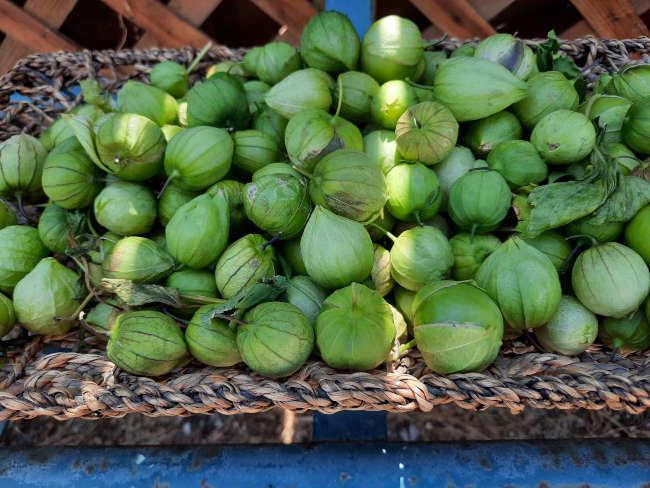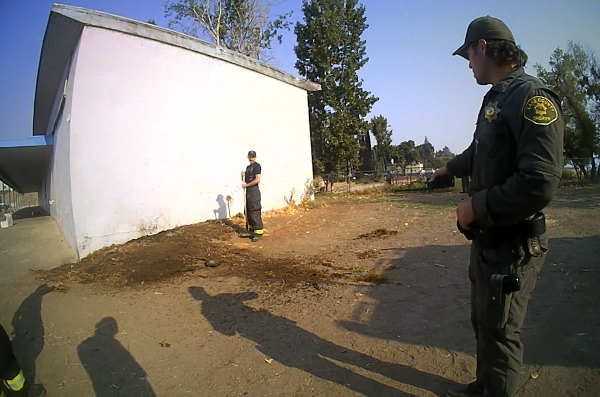- ESTHER OERTEL
- Posted On
Mensam Mundum — World Table: Small but mighty — tart, tasty tomatillos

MIDDLETOWN, Calif. — Thanks to a generous literacy student, I found myself with a big bag of fresh tomatillos the other day.
They were just perfect — small, bright spheres of green covered with brownish papery husks. As a fan of salsa verde, this was pretty exciting for me.
The happy little fruits stared at me from the bag and my mind raced with ideas for their use. I’d turn some of them into salsa verde, of course, but other ideas popped up, too, like cooking them with a big batch of pinto beans for a vegetarian version of chili verde.
As it happened, I had limited time to put these plans into action, so I offered them to my son. This ended up being a great decision because he worked his magic to turn them into the best salsa verde I’ve ever tasted! It had a rich, smoky flavor, yet maintained the signature tartness expected from tomatillos.
I can let you in on the secret to his success in the recipe below. But first, a bit about this sassy little fruit.
Despite its name, which means “little tomato” in Spanish, tomatillos are not, in fact, little tomatoes. They’re members of the nightshade family like the tomato, so you might call them cousins, but they’re a species distinct from them.
The Cape gooseberry, which also grows encased in a thin husk, is another nightshade relative of the tomatillo.
Like many members of this family, parts of the plant are toxic. In the case of the tomatillo, the stems, leaves and husk are poisonous and should be avoided.
Other names for the tomatillo include husk tomato, Mexican husk tomato or, in Mexico, tomato verde. In Spain they’re known by a variety of names, my favorite being farolito, which translates to little lantern. Because of their papery husks, they do remind me of the paper lanterns strung everywhere during Chinese New Year celebrations.
Tomatillos are native to Mexico and parts of Central America. There’s evidence that they were cultivated in Mexico in pre-Columbian times, since at least 800 B.C., where they were eaten by the Aztecs and Mayans.
They’re still mostly associated with Mexican and Central American cuisine. (Think of delicious, tangy green salsa or the brightly flavored sauce served over pork or chicken enchiladas.)
Like tomatoes or cucumbers with internal seeds, they’re botanically considered a fruit, though in practice they’re used in savory cuisine like a vegetable.
Typically golf ball sized (though this can vary), each fruit has a thin husk that dries and recedes when they’re ripe. Depending on the variety, they can ripen to varying shades of yellow, red, or purple, just like their tomato cousins.
Tomatillos are most often harvested prior to maturity when bright apple green with a just-burst husk. This is when their tangy flavor is in full force and they still have their signature acidic edge. The flavor mellows as the fruit matures.
Heat-loving tomatillos have been cultivated in the U. S. since 1863. In California, they’re grown commercially on the central coast as well as in the Central Valley. Depending on the warmth of their location, harvesting can begin as early as late May and last through November.
If you’re in the market for tomatillos, look for those that have a husk that’s dry and not shriveled or damp. The husk should cover the fruit and be somewhat tight, though open at the end. This indicates that the tomatillos were picked just before ripening.
In addition, the fruit should be firm without much give, with no brown or soft spots, and be a vivid shade of green like a Granny Smith apple.
When you get them home, decide how long it will take you to use them. If right away, there’s no need to refrigerate, as they’ll store well on the counter for two to three days.
If you’d like to keep them around longer, place them in a partially open paper bag and store them in the refrigerator, where they’ll keep for two to three weeks.
Once the husks are removed, the sticky, protective residue on their skin will be revealed, and you’ll need to wash that off before working with them.
They’re really quite versatile and can be used in a variety of ways. Like tomatoes, the skin and seeds are edible and there’s no need to peel or seed them.
Despite the way they look and their relationship with tomatoes, tomatillos are too acidic to be subbed in recipes that feature green tomatoes.
Use them raw if you want to keep their flavor bright and to play up their bracing acidity. Raw tomatillos can be a component of ceviche, for example, or used in a salad with tomatoes, corn and avocado.
Raw tomatillos can also be used in vinaigrette dressings to provide additional brightness and acidity.
When tomatillos are cooked, their acidity is mellowed a bit (though they’ll still have that tang) and a subtle sweetness is brought out. This is particularly true when they’re roasted. Cooking of course softens them, and it mutes the color, as well.
There are a variety of ways to cook them.
Blanching tomatillos in boiling water for five minutes or so mellows the flavor and softens them for crushing or pureeing.
They can be fire roasted under the broiler, on the grill, or even with a propane torch. If using this method, be sure the heat is high to avoid mushyness before they’ve had a chance to char. The blackened skins will add smoky flavor to your dish.
They can be dry roasted with low heat for 20 to 30 minutes in the oven or in a cast iron pan on the stove. Turn them occasionally while they’re cooking.
They can be added directly to the pot to simmer with soups like pozole verde or braised with chicken or pork for stews like chili verde. They can be cooked with beans to add flavor and tang, or grilled with onions to make an accompaniment for steak or other hearty foods.
Or they can be smoked, which is what my son did to make his epic salsa verde. His recipe is below.
But before we go, here’s an interesting fact. A fossilized tomatillo was found in the Patagonia region of South America that dated to 52 million years ago. I wonder what that would taste like in a salsa?

Bob’s Salsa Verde
6 or more cups tomatillos
3 jalapeno peppers
3 serrano peppers
2 pasilla peppers
2 bulbs (not cloves) of garlic
Olive oil
Red onion, roughly chopped
Cilantro, one bunch, leaves only
Juice of one lime
About ¼ cup red wine vinegar
Salt to taste
Smoke the peppers, tomatillos and garlic in an electric or wood smoker on low heat — about 250 to 275 degrees Fahrenheit — for 1 to 1 ¼ hours, until soft and smoky. Notes: Bob used a wood smoker fueled by oak and cherry logs. The tomatillos should be placed in a pan for smoking so the juices can be retained for the salsa. Garlic bulb tops should be cut off, then rubbed with oil and wrapped in aluminum foil for roasting.
Place the smoked peppers, tomatillos and garlic (without skins) in a blender or food processor and puree on the pulse setting with the red onion, cilantro, lime juice and vinegar. Notes: Garlic bulbs can be squeezed to release the smoked garlic cloves inside. Be sure to add the tomatillo juice in the pan to the puree, as well.
Add salt to taste, a pinch or so. Bob thinks the pinch he added is about half a teaspoon. Start with a quarter teaspoon, taste, and add more if needed.
Store in glass jars with lids in the refrigerator, where it should stay fresh for about two weeks.
Note that salsa verde can become a little gelatinous when cold. This can be remedied by bringing to room temperature or heating for a few seconds in the microwave.
Use as you would any salsa verde - over enchiladas, to flavor soups or stews, atop meats and vegetables, with chips. For a treat, mix it with guacamole for a flavorful dip!
Recipe by Bob Oertel.
Esther Oertel is a writer and passionate home cook from a family of chefs. She grew up in a restaurant, where she began creating recipes from a young age. She’s taught culinary classes in a variety of venues in Lake County and previously wrote “The Veggie Girl” column for Lake County News. Most recently she’s taught culinary classes at Sur La Table in Santa Rosa. She lives in Middletown, California.






















